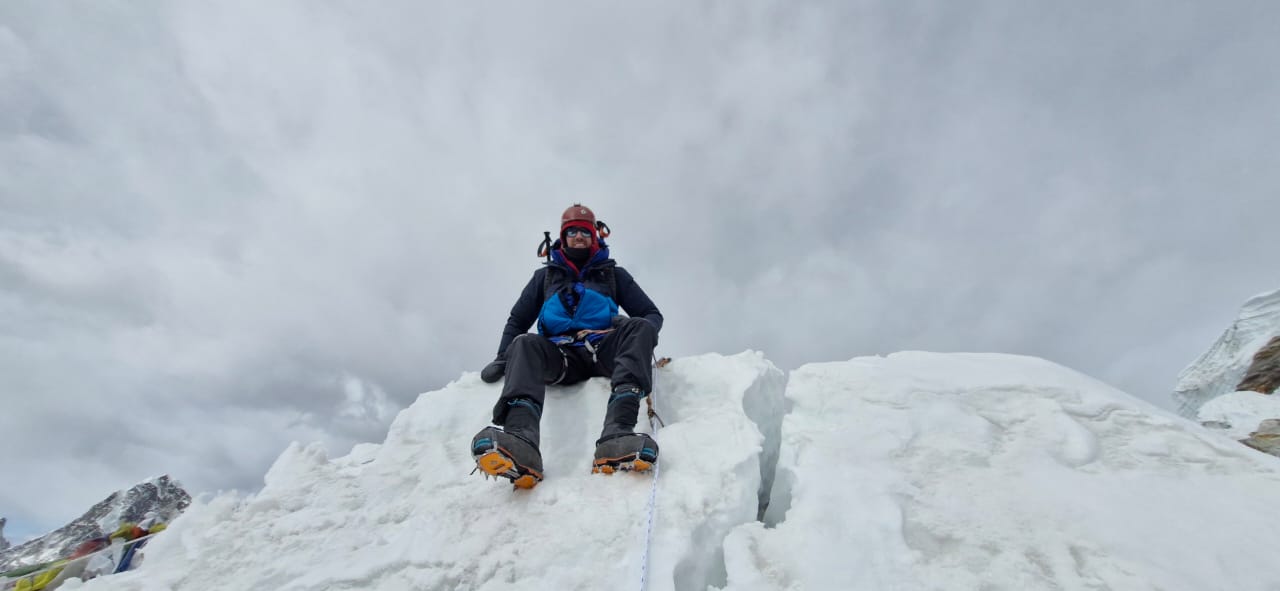LOBUCHE PEAK CLIMBING 8 DAYS
Lobuche Peak Climbing is an exciting 8-day scenic peak climbing in the Himalayas that is the perfect opportunity for experienced trekkers and those without experience who are seeking for a brief challenging climbing expedition. Standing tall at 6119m, Lobuche East is a technical peak with an unparalleled view of Everest, Lhotse, Nuptse, and more.
The journey to the mountain starts with a spectacular 35-minute mountain flight from Kathmandu to Lukla, the gateway of the Everest region. The hike starts from here, and you walk to Phakding along the Dudh Koshi River. The following day, you climb up to the lively Sherpa town of Namche Bazaar. There, you’ll have an extra day to get acclimatized, hiking around the area and taking in views of Everest, Ama Dablam, and more. And we won’t be climbing today, this is a mandatory rest day if we are to climb in a safe and successful way.
After Namche, the trail traverses Tengboche and to Pangboche, where you will find the first monastery ever built in the region. Here, you turn onto the trail to Lobuche High Camp and beyond (No. 1). High Camp at 5,600 meters is the starting point for the summit push.
Summit day starts early, as climbers climb the snowy ridge, with fixed lines, to the top of Lobuche East. The ascent is difficult and the terrain technical, and crampons, an ice axe, and a good level of fitness are required. The summit offers spectacular views of the Khumbu Himalayas, and the rewards of this climb are more than worth the challenge.
Celebrate your achievement and recover, followed by another descent to Thukla and another day's trek to Pheriche. A short helicopter ride from this scenic alpine village brings you again to Lukla, where you will have the last look at the region from the air. The trek finishes up with a normal flight back to Kathmandu and ends what has been a truly remarkable journey.
This tight hit of high-octane on the peaks combines challenging climbing, Sherpa life, and big Himalayan views with the least possible number of days – just 8!
Important Alert:: This climbing expedition is only suitable for experienced trekkers. Due to the rapid itinerary, high altitude, and technical sections of the climb, prior high-altitude trekking and basic mountaineering skills are essential. This trip is not recommended for beginners or those without proper acclimatization experience.
ITINERARY
Day 1 : Fly to Lukla (2,804m) & Trek to Phakding (2,640m) Duration: 4–5 hours.
The adventure begins with a thrilling 35-minute flight from Kathmandu to Lukla, where you'll be greeted by panoramic views of the Himalayas. After landing at Lukla’s Tenzing-Hillary Airport, you’ll begin your trek towards Phakding, a quaint village along the Dudh Koshi River. The trail descends gradually through pine forests and small Sherpa settlements, offering your first taste of the Everest region's beauty. You’ll reach Phakding by afternoon, where you’ll stay overnight in a local teahouse.
Day 2 : Trek from Phakding to Namche Bazaar (3,440m) Duration: 5–6 hours.
Today’s trek takes you through suspension bridges and forested paths along the Dudh Koshi River. After passing through Monjo, you’ll enter Sagarmatha National Park, where you’ll start ascending towards Namche Bazaar. The trail becomes steeper, but the stunning views of Everest, Lhotse, and Ama Dablam will motivate you to push forward. Upon reaching Namche, a vibrant Sherpa town and the commercial hub of the Khumbu region, you'll enjoy a well-deserved rest.
Day 3 : Acclimatization Day at Namche Bazaar.
An important rest day for acclimatization to adjust to the increasing altitude. You can take a short hike to Everest View Hotel, located at a higher altitude for stunning views of Mount Everest and the surrounding peaks. You can also explore the local markets, visit the Sherpa Museum, or interact with the locals to learn about the Sherpa culture.
Day 4 : Trek from Namche to Pangboche (3,930m) Duration: 5–6 hours.
Leaving Namche, the trail offers magnificent views of the Khumbu Himalayas, including Everest, Lhotse, Nuptse, and Ama Dablam. The trek takes you through the picturesque villages of Khumjung and Monjo, before crossing the Imja Khola and climbing towards Pangboche. This village is home to the oldest Buddhist monastery in the Khumbu region and provides an excellent view of the mighty Ama Dablam.
Day 5 : Trek from Pangboche to Thukla (4,620m) Duration: 5–6 hours.
Today’s trail takes you through high-altitude terrain, with majestic views of surrounding peaks. After a short descent and crossing a river, you’ll climb steeply towards Thukla, a small settlement nestled at the foot of the Khumbu Glacier. The views of Mount Pumori and Nuptse will be ever-present as you reach Thukla, where you’ll stay overnight to rest and prepare for the challenging ascent ahead.
Day 6 : Trek from Thukla to Lobuche High Camp (5,600m) Duration: 5–6 hours.
Today, you’ll leave the main Everest Base Camp trail and head towards Lobuche High Camp. The path becomes more rugged as you ascend through the Khumbu Glacier moraines and pass icefall landscapes. The trek is physically demanding, but the views of Everest, Lhotse, and Pumori provide motivation. Upon reaching Lobuche High Camp, you’ll rest and go over your climbing gear and techniques in preparation for the summit push the following day.
Day 7 : Summit Lobuche Peak (6,119m) & Descend to Thukla Duration: 9–10 hours.
The day starts early, typically around 2 AM, as you begin your ascent to the summit of Lobuche East. The climb requires technical skills, including crampons, ice axes, and fixed ropes. The summit push involves navigating snow-covered ridges and steep, rocky sections. Reaching the 6,119-meter summit offers unbeatable panoramic views of Everest, Lhotse, Nuptse, Makalu, and Pumori. After celebrating your success, you’ll begin your descent back to Thukla for the night.
Day 8 : Trek to Pheriche, Helicopter Fly to Lukla & Flight to Kathmandu.
After descending from Thukla, you’ll continue down to Pheriche, where you’ll catch a helicopter flight back to Lukla. This helicopter ride provides a scenic aerial view of the Himalayas, offering a quick and comfortable descent compared to the long trek back. Once you arrive in Lukla, you’ll take a return flight back to Kathmandu, completing your unforgettable 8-day Lobuche Peak Climbing adventure.
SERVICES
Costs Included in Your Package
- Domestic Airport Pick-Up and Drop-Off: Private car or jeep transfer from/to the airport for your convenience and comfort.
- Meals During the Trek: Three nutritious meals per day (breakfast, lunch, and dinner), including fresh fruit served each evening after dinner.
- Scenic Helicopter Transfer: Shared helicopter flight from Pheriche to Lukla, offering a spectacular aerial view of the Himalayas.
- Accommodation: Comfortable trekking lodge (tea house) stays during the trek, and tented camp accommodation during the Lobuche Peak climbing session.
- Permits and Entry Fees: All necessary paperwork, including the Sagarmatha National Park Entry Permit and Khumbu Pasang Lhamu Rural Municipality fees.
- Flights and Transfers: Round-trip domestic flights (Kathmandu–Lukla–Kathmandu via Ramechhap) with private airport transfers and applicable airport taxes.
- Experienced Trekking and Climbing Guide: An English-speaking, government-licensed guide who is friendly, knowledgeable, well-trained, and fully insured—covering all his expenses, including salary, food, accommodation, transport, and insurance.
- Lobuche Peak Climbing Permit: Official permit for climbing Lobuche Peak.
- Sherpa Porters: Reliable, helpful Sherpa porters (one for every two trekkers) equipped with proper safety and walking gear. Their salary, meals, accommodation, and insurance are covered.
- Medical Support: A Comprehensive first aid kit is available throughout the trek for your safety and peace of mind.
- Emergency Helicopter Arrangement: Coordination of emergency helicopter evacuation (covered by your personal travel insurance, if required).
- Essential Trekking Gear (On Loan): Complimentary use of sleeping bag, down jacket, duffel bag, and walking poles (to be returned after the trek).
- Exclusive Souvenirs: Sherpa Expedition & Trekking T-shirt and a trip achievement certificate upon successful trip completion.
- Health Monitoring: Daily use of an oxygen meter to monitor your pulse, oxygen saturation, and heart rate—crucial for detecting early signs of Altitude Mountain Sickness (AMS).
- Assistant Guide: An additional assistant guide will be provided for groups of 8 or more trekkers to ensure safety and personalized attention.
- Government Fees and Taxes: All government taxes and official expenses are included.
Costs Excluded from Your Package
- Meals in Kathmandu: Lunch and dinner while staying in Kathmandu are not included.
- Hotel Accommodation in Kathmandu: Accommodation in Kathmandu before or after the trek is not covered.
- Nepal Entry Visa: The Nepal visa fee is not included. Visas are available on arrival at Tribhuvan International Airport:
- $30 USD for 15 days
- $50 USD for 30 days
- $125 USD for 90 days
- Travel & Medical Insurance: Personal travel and medical insurance (mandatory for trekking and climbing).
- International Airfare: Flights to and from Nepal are not included.
- Personal Expenses: Any personal spending such as souvenirs, laundry, and snacks.
- Drinks & Snacks During the Trek: Alcoholic and non-alcoholic beverages (including tea, coffee, soup, hot chocolate, cocoa, bottled water), as well as any extra food items purchased along the way or at tea houses (e.g., additional meals, snacks, desserts like chocolate, cake, pudding, etc.).
- Extras at Tea Houses: Charges for hot showers, Wi-Fi, and battery charging at trekking lodges are not included.
- Tips: Gratuities for guides, porters, and drivers (tipping is customary and appreciated).
- Excess Baggage Fees: Extra baggage over 10 kg on the Lukla flight may incur additional fees.
- Early Return from Trek: In case of an early return due to illness or any unforeseen reason, the cost of unused services (flights, accommodations, meals, etc.) is non-refundable. Any additional expenses in Kathmandu (hotel, meals, etc.) will be your responsibility.
EQUIPMENTS
You’ll carry your personal gear and share some group equipment, so pack light with layered, weather-appropriate clothing—avoid cotton and choose breathable, insulating fabrics. A windproof duffle (provided and carried by porters) and water are included. Non-trekking items can be stored in Kathmandu. Sherpa Expedition & Trekking supplies all essential expedition gear.
Upper Body:
- Base Layers: Moisture-wicking and quick-drying shirts and thermal tops.
- Insulation Layers: Fleece or down jackets to provide warmth.
- Waterproof Shell Jacket: A durable and breathable jacket to protect against wind and rain.
- Softshell Jacket: A lightweight and water-resistant jacket for added protection.
- Climbing Harness: A comfortable harness to secure yourself to the rope.
- Helmet: A strong and well-fitting helmet to protect your head from falling objects.
- Gloves: A combination of lightweight liner gloves and insulated gloves or mittens for warmth and dexterity.
- Buff or Neck Gaiter: To protect your neck and face from cold and wind.
- Sunglasses: Polarized and UV-protected sunglasses to shield your eyes from the sun and snow glare.
- Goggles: Ski or mountaineering goggles for added eye protection in extreme weather conditions.
Lower Body:
- Base Layers: Moisture-wicking and quick-drying thermal bottoms.
- Insulation Layers: Fleece or insulated pants for added warmth.
- Waterproof Shell Pants: Durable and breathable pants to protect against wind, rain, and snow.
- Softshell Pants: Lightweight and water-resistant pants for added protection.
- Mountaineering Boots: Sturdy and insulated boots designed for snow and ice.
- Crampons: Attachable spikes that provide traction on icy terrain.
- Gaiters: Waterproof and breathable gaiters to keep snow out of your boots.
- Socks: A combination of moisture-wicking liner socks and thick, warm mountaineering socks.
Other Essential Items:
- Backpack: A spacious and sturdy backpack to carry your climbing gear and personal belongings.
- Sleeping Bag: A warm and lightweight sleeping bag that can withstand sub-zero temperatures.
- Trekking Poles: Adjustable trekking poles for added stability and support.
- Headlamp: Essential for climbing in low-light or dark conditions.
- Water Bottles: Insulated water bottles to keep your water from freezing.
- Sunscreen: High SPF sunscreen to protect your skin from the strong sun at high altitudes.
- First Aid Kit: A comprehensive first aid kit with essential medications and supplies.
- Climbing Snacks: Energy bars, nuts, and other lightweight snacks for quick fuel during the climb.
It is important to invest in high-quality gear and ensure that everything fits properly and is in good condition. Additionally, consult with experienced climbers or a professional guide to ensure you have all the necessary gear and receive proper training on how to use it effectively and safely.
Note: Essential climbing equipment, including an ice axe, crampons, climbing boots, harness, helmet, safety rope, ascender (jumar), and carabiner, can be hired in Dongboche. The total cost is approximately USD 120 per person for a complete set.
GOOD TO KNOW
📅 Best Time to Climb
The best time to attempt Lobuche Peak Climbing is during spring (March to May) and autumn (September to November). These months offer the most stable weather conditions, with clear skies, minimal rainfall, and ideal temperatures for trekking and climbing. Spring offers the added bonus of rhododendron blooms, while autumn provides stunning views of the snow-covered peaks.
💪 Physical Fitness
Climbing Lobuche Peak is physically demanding and requires a good level of fitness, endurance, and prior trekking experience, especially at high altitudes. While prior mountaineering skills are not mandatory, being comfortable with long days of trekking (5–8 hours) and the ability to handle strenuous uphill climbs is essential. Training in aerobic fitness, hiking, and strength exercises will prepare you for this challenging trek.
🧗 Technical Skills
Lobuche East is a technical trekking peak, which means you'll need basic mountaineering skills. You’ll be climbing snow and ice-covered slopes, using fixed ropes, crampons, and ice axes. Having previous experience with glacier travel and basic rope work will be beneficial, but your guide will provide necessary instruction before the summit attempt.
🏔️ Acclimatization and Altitude
Acclimatization is vital to avoid altitude sickness. The trek includes proper rest days, like in Namche Bazaar, allowing your body time to adjust to the increasing elevation. Always listen to your body—if you feel dizzy, nauseous, or extremely fatigued, report these symptoms immediately to your guide.
🚁 Helicopter Evacuation
A helicopter ride from Pheriche to Lukla is included, which not only offers a time-saving descent but also provides an opportunity to enjoy breathtaking aerial views of the Khumbu Valley. This helicopter ride allows climbers to skip the long walk back to Lukla, reducing the physical strain after summiting Lobuche Peak.
🛂 Permits and Documentation
To climb Lobuche Peak, you will need several permits:
NMA (Nepal Mountaineering Association) permit for the peak
Sagarmatha National Park Permit for entering the Everest region
TIMS (Trekkers’ Information Management System) card for trekking in Nepal
These permits can typically be arranged through your trekking agency, but it’s always good to confirm. Remember to carry valid travel insurance that covers emergency evacuation and mountaineering activities.
MAP
PHOTOS/Videos
Departures
Select a departure month
Fill out the form below and a Travel Expert will reach out to create your perfect tour.
FAQS
How difficult is Lobuche Peak Climbing?
Lobuche Peak is a challenging climb suitable for experienced trekkers and climbers. It involves technical sections such as using crampons, ice axes, and fixed ropes. Good physical fitness and prior high-altitude experience are essential for success.
Do I need prior climbing experience?
While you don’t need to have summited other peaks, it’s recommended to have basic mountaineering skills, such as using crampons, ice axes, and fixed ropes. Experience at high altitudes and familiarity with trekking in snow and ice will help significantly.
What is the highest point of the trek?
The highest point of the trek is the summit of Lobuche East, standing at 6,119 meters (20,075 feet). Reaching this altitude requires proper acclimatization and preparation.
What is the best time to climb Lobuche Peak?
The best seasons for Lobuche Peak climbing are spring (March–May) and autumn (September–November). These months offer stable weather conditions, clear skies, and ideal temperatures for both trekking and climbing.
How long is the trek to Lobuche Peak?
The trek lasts 8 days, including acclimatization and summit day. This includes trekking to various altitudes, allowing your body to adjust before the technical climb to the peak.
Is altitude sickness a concern?
Yes, altitude sickness can affect climbers at high elevations, especially above 3,000 meters. The itinerary includes acclimatization days to help reduce the risk, but it's crucial to stay hydrated, listen to your body, and descend if necessary.
What kind of accommodation can I expect?
During the trek, you will stay in teahouses (lodges) in villages like Namche Bazaar and Pangboche, which offer basic comfort. At Lobuche High Camp, you will stay in tented camps as you prepare for the summit attempt.
What permits do I need for the trek?
You will need:
NMA (Nepal Mountaineering Association) climbing permit
Sagarmatha National Park entry permit
TIMS (Trekkers' Information Management System) card
Your trekking agency can arrange these permits for you.
How does the helicopter evacuation work?
After the summit, you will take a helicopter flight from Pheriche to Lukla, bypassing the need for a long trek back. This is included in the package and helps save time and reduce physical strain.
Is travel insurance required for the trek?
Yes, travel insurance is mandatory. It should cover emergency evacuation, high-altitude trekking, and mountaineering activities, including helicopter evacuation in case of an emergency.
Latest Traveller’s Reviews
Travel experiences of our clients who recently returned from their trips.
100%
Based On 896 Reviews
Reena Kuhrram
United States
September 17, 2024
Wonderful Experience from Start to Finish
I had a wonderful experience trekking to Everest Base Camp with Sherpa Expedition and Teams. The level of professionalism and care was evident from the start. Our guides were excellent at facilitating our acclimatization and ensuring everyone was in good spirits. The breathtaking landscapes and the warm hospitality in the teahouses made the trek unforgettable. I felt a true sense of camaraderie with fellow trekkers, all thanks to the fantastic atmosphere the Sherpa team created.
Daniella Garcia
Austria
September 2, 2024
Unforgettable Journey
My trek to Everest Base Camp with Sherpa Expedition Teams was nothing short of magical. The guides were incredibly knowledgeable and attentive, ensuring our safety and comfort throughout the journey. The breathtaking views, especially of Khumbu Glacier, left me in awe. Every meal was delicious, and the teahouses were cozy. I felt genuinely supported every step of the way. I highly recommend Sherpa Expedition for anyone seeking an adventure of a lifetime!
Laurence Fang
United States
August 29, 2024
Epic Adventure!
Trekking with Sherpa Expedition and Teams was an epic adventure. Their expertise in organizing the trek was apparent, and our guide was a wealth of knowledge. The trek itself was challenging yet thrilling, with stunning views that took my breath away. I felt safe and supported throughout, and the local culture added an enriching layer to the experience. Reaching Everest Base Camp was a dream realized. I wholeheartedly recommend this team for anyone looking for an incredible trek!
People Considering This Package Right Now Check availability






















